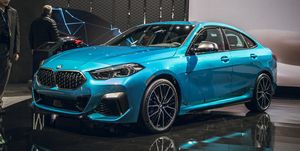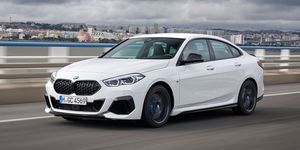One incontrovertible truism in the car business is that vehicles get bigger with time. Today’s Honda Fit, for example, is about the same size as the original Accord. The current Ford Ranger is a foot and a half longer than a 1980 F-150.
BMW has resisted this trend better than most. The first 3-series, the 1976 320i, was 177.0 inches long. The 2004 330i (E46) was actually an inch shorter. Then the dam burst. The next three generations all grew between two and four inches longer, resulting in the current 3-series reaching 185.7 inches long. Suddenly, there’s room at the bottom for a “small” BMW sedan—the 2020 2-series Gran Coupe, the long-awaited competitor to the Audi A3 and the Mercedes CLA-class. It’s about seven inches shorter, an inch narrower, and an inch lower than the current 3-series. It’s also the first BMW car to be sold in the United States that’s based on a front-wheel-drive platform. What are we to make of such a machine?
A High-Tech Compact
The new 2-series sedan, which we sampled in 228i xDrive guise for this test, is hardly a minicar, casting almost the same shadow as the 2007 BMW 335i I once owned. Yet, despite its front-drive-based layout, which promises better packaging efficiency, this 228i has less interior room than my old 3-series, particularly in the rear, where every measurement is smaller than the older car’s.
The front-seat area, however, is roomy and smartly arranged. The driving position is better than in many larger BMWs because you can position the steering column low enough so that it points at your upper body and not your head. The minor controls are also well laid out, and the latest iDrive infotainment system works superbly—as it does on all modern BMWs—once you get used to its obtuse menu arrangement.
There are a couple of irritants. The speed-limit-assist feature sets your cruise-control speed at the speed limit whenever you engage the set button. With BMW’s consistently and inexplicable optimistic speedometers, this means that you are actually traveling at 1-2 mph under the limit, rather than 3-5 mph over, where a reasonable driver would be. Then there’s the auto hold, which engages the parking brake whenever you come to a stop. This feature not only requires a larger accelerator push to get going, but it also impedes the stop-start operation so that the engine doesn’t restart when you lift your foot off the brake, but only when you start depressing the accelerator. Both systems were quickly disabled on our test car.
Nuisances aside, the cockpit works better than it looks. While the optional Mocha Perforated leather, with its contrasting stitching, is rich and elegant and the switchgear has a high-quality feel, the surrounding trim looks like a catalog of every type of black plastic extant. There are glossy, piano-black surfaces around the shifter and central console, satin-black pebble-grain on the doors, flat-black pebble grain on other parts of the doors, smooth satin black around the vents, diamond-pattern black on the instrument binnacle, along with shiny triangular-pattern embossed trim spears on the dash and doors. The Bauhaus edict that less is more was lost on the 228i’s interior designers.
Drives like a BMW
From the outside, the 228i is an anodyne-looking machine. Were it not for the faux twin-nostril grilles—they appear to be blocked, with most of the airflow coming from below—it would be hard to identify it as a BMW. It doesn’t even have the Hofmeister kink, that forward cut at the leading edge of the C-pillar that has characterized BMWs for nearly 60 years. However, as that design detail has been said to suggest rear-wheel drive, perhaps its absence reflects a certain design integrity.
Fittingly for a BMW, the best part of the 228i is driving it. The steering is accurate and responsive without feeling skittish. There isn’t a huge amount of feedback from the front tires, but the car goes immediately where you point it. Although there are two levels of steering effort, Comfort mode feels more linear than the Sport setting, which adds an artificial on-center weightiness. In neither mode did we detect even a hint of torque steer.
In everyday driving, the all-wheel-drive 228i xDrive provides a comfortable, well-controlled ride that even takes potholes in reasonable stride—and that’s even with low-profile 18-inch 225/40R-18 run-flat tires fitted to our test car.
Pushed hard in the Rocky Mountain foothills near Denver, the 228i performs well, but without the playful ability to balance the handling that rear-drive BMWs provide. Perhaps that’s because 58.8 percent of the 228i’s 3517-pound weight sits on its front wheels. Only 52.4 percent of the current 330i xDrive’s weight does. Though the 228i doesn’t understeer significantly, its rear end doesn’t want to step out at all. If our test car’s 0.85 g of cornering grip seems low and its 176-foot 70-mph-to-zero stopping distance long, keep in mind that we were on Bridgestone Turanza LS001 all-season tires. The flip side of that less-performance-oriented setup was decent traction and stability on a treacherous snowy day when numerous vehicles ended up in ditches.
Ample Turbo Power
The 228i puts its traction to good use, efficiently harnessing the power of its engine. This detuned version of BMW’s turbocharged 2.0-liter inline-four develops 228 horsepower and 258 lb-ft of torque, which is more than 10 percent less than the engine delivers in the 330i. Compared to the M235i Gran Coupe model (that we have yet to test), the 228i is down 73 horses and 74 lb-ft. Yet, the acceleration of the 228i is virtually identical to that of the 330i xDrive that we tested last year. Only 5.1 seconds is needed to hit 60 mph, and the car covers the quarter-mile in 13.8 seconds at 99 mph.
As with most small turbocharged engines, there is a bit of turbo lag if you flat-foot the throttle from a standing start. At altitude, this is exaggerated, and it seems to take two beats before the engine delivers its best. This isn’t obvious during moderate driving. Once underway, thrust is immediate and plentiful, with the 228i delivering a decent, if artificially enhanced soundtrack.
Compared with the 330i, the 228i is geared shorter everywhere but in fourth gear. First gear, which is critical to a good launch, is more than 10 percent lower. The downside of this is that the smaller, lighter, and less powerful 228i gets fractionally poorer fuel economy than the 330i xDrive. Rated by the EPA at 23 mpg city and 33 mpg highway, those figures are 2 and 1 mpg less, respectively, than its larger sibling’s. That said, the 228 is rather fuel efficient. We measured 37 mpg over our 75-mph highway test (1 mpg less than the 330i xDrive).
Which brings us to the bottom line. The base price of the 228i xDrive is $38,495, compared with $43,745 for a 330i xDrive. That’s a savings of $5250. Of course, few of these cars are likely to be sold as base models. For our money, we’d pay the extra for the roomier, more attractive, and better handling 330i. We might even select the rear-drive 330i and cut that premium by $2000.
Source: Reviews - aranddriver.com





